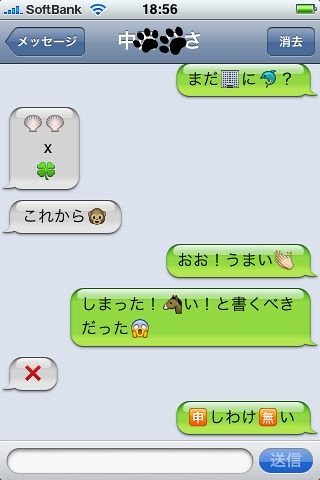
I just read a story on Ars Technica that says Apple issued App Store wide Emoji app take-down order:
I found this as very interesting story that I posted a few comments there but let me describe what I told over there.
Not many people (even in Japan) realizes but the Emoji on iPhones today is called SoftBank Emoji and it is the Emoji designed by SoftBank, the operator that sells iPhone here in Japan.
In Japan, there has been a rumor about NTT DoCoMo, one of the oldest (and largest) operator might also get a deal with Apple. It didn't happen for the past seven months but I believe both Apple and NTT DoCoMo is anticipating such deal in the future.
But if SoftBank emoji became the standard on iPhone/iPod touch, it would make that deal difficult.
I think there could have been some tactical aspect in SoftBank asking Apple to put SoftBank emoji on iPhone OS. Masayoshi Son is one of the most genius guy in Japanese IT industry (he might be one of the only few who is serious about the future of IT in Japan).
Now some of you might ask, why it's SoftBank emoji and not universal emoji?
Universal emoji has been my dream. I begged for it on my Japanese blog in August 2008;
But you have to realize Japanese mobile phone operators are so close minded.
They don't allow people to SMS to users of other operators.
And they don't like people sending emoji e-mail to people who are using phones from other operators.
And because of this close culture, things don't work in Japan as it supposed to.
For example, if you are an iPhone users visiting Japan, you may find that you are not receiving any SMS sometime. Well that's because you are roaming on NTT DoCoMo's network; as soon as, you switch the network to SoftBank, you will start receiving SMS again (each SMS would cost a $1 though).
And because of this close culture, all three major operators have different set of emojis and they are incompatible until recently when some company came with server-side conversion service.
NTT DoCoMo has the biggest accumulated number of customers in Japan. And they want to build their success on it; so they wouldn't license their emoji, so those people who receives emoji e-mail often would want to switch to DoCoMo. KDDI did the same. And SoftBank had to follow that tradition.
Maybe, the root of the problem is within the Japanese culture but they are incapable of making international standards especially making it collaborative way; Most of the previous Japan made standard such as VHS vs beta or HD-DVD vs Bluray ultimately came out from winner-takes-all games.
Thus we have to rely on American companies such as Apple or Google to standardize the Japan-born emoji.
Actually, those two companies are working hard right now to put emoji characters into the Unicode standard.
BTW. some of you may ask if the emoji conversion can be a built-in feature on the handset.
Of course, it can be but it won't happen.
Japanese handset manufacturers are not allowed to have their own opinion or suggestions (or at least that is how they feel); in Japan, most phone specs are decided and approved by the carriers. Most manufacturers sit and wait. I think this ill-fated tradition in the Japanese mobile phone industry made all Japanese mobile phonesSO UNATTRACTIVE.
You would believe the handset manufacturers has to take careful look on their customers and make the handset that customers want.
Well, this simple and most basic theory doesn't work in Japan.
In Japan, the manufacturers are like the slave of the carriers; for every action or decision they would make, they have to ask if its master (i.e. carrier) like that idea.
And in most cases, it is the Japanese carrier who decide such thing as "on the next Spring model, we will want you to put MP3 player as well as built-in TV."
Japanese mobile phone industry is such a big bureaucratic shit.
And because the carrier can only operate within Japan, they have no interest in making international standards, etc.
You will see that strangeness everywhere:
-Japanese cell phone has very different set of Bluetooth profile
-Japanese cell phone uses older version of vCard because they are using IrDA standard which involves older version of vCard
etc. etc.
Nokia phones and iPhone were very special cases in Japan; they've opened the flood gate for many other foreign handset manufacturers while Nokia retreated just as they were finally becoming popular in Japan.
---
after posting above, I found this very interesting article about emoji on CNet Japan:
Emoji opened up the Pandora's box
by Katsuhiro Ogata
This article describe the history of emoji as well as how complicated the emoji conversion could be without a universal emoji table which covers emoji from all three carriers such as Unicode.
On the last page of the five pages article, Mr. Ogata had interviewed the representative of al three characters about how they feel about Google's effort of integrating emoji into Unicode standard and if they would support that effort:
NTT DoCoMo: Interested. Will watch their effort / don't know yet if they would cooperate
KDDI: don't know the detail but will watch / will consider
SoftBank: Standardizing emoji is very important. We will watch its effort / we are not ready to discuss
Ogata-san said Emoji opened the Pandora's box.
But if it were not iPhone, this Pandora's box have not opened; and I think the future generations would have to appreciate iPhone for making this change happen.
If it were not iPhone, Japanese still would have kept that 2-3 phones per year development cycle and produced mass waste of mobile phones and Japanese yen without making any technological progress.